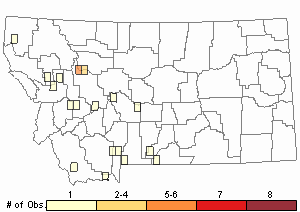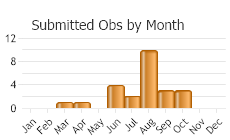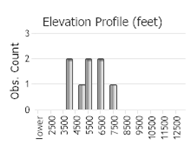View in other NatureServe Network Field Guides
NatureServe
Montana
Utah
Wyoming
Idaho
Wisconsin
British Columbia
South Carolina
Yukon
California
New York
Silky Vallonia Snail - Vallonia cyclophorella
General Description
A small shell, to 3.4 mm diameter and 1.4 mm in height, flattened heliciform with regularly spaced blade-like axial ribs, about 3 1/2 whorls, the last descending at the aperture. Shell coloration is translucent whitish, gray or pale brown. Aperture lip is abruptly flared but not thickened with an internal callus; umbilicus wide, about 1/2 to 1/3 the shell diameter. Animal is white (Hendricks 2012, Burke 2013).
Diagnostic Characteristics
Combination of small size (< 3.5 mm diameter), flattened heliciform shape, flared lip, and color (translucent white to pale brown) separate Vallonia from other shells. An unthickened lip distinguish V. cyclophorella and V. perspectiva from V. pulchella and V. gracilicosta. V. cyclophorela has regularly spaced blade-like axial ribs, and an umbilicus about 1/3 the shell diameter while V. perspectiva has evenly-spaced ribs and an umbilicus about 1/2 the shell diameter. V. cyclophorella is similar in structure to Vallonia perspectiva but larger (up to 3.4 mm diameter compared to 2.0 mm, respectively).
Species Range
Montana Range
Range Descriptions

 Native
Native
Range Comments
Western North America from Alaska to the southwestern United States, east to Alberta, North Dakota and Texas (Forsyth 2004, Burke 2013). In Montana, reported on both sides of the Continental Divide from 12 counties: Beaverhead, Gallatin, Granite, Lake, Lewis and Clark, Lincoln, Meagher, Missoula, Park, Powell, Stillwater, Teton. Elevation range is 1320 to 2300 m (4330 to 7545 ft). May be locally common; 23 were found at one Teton County site in early August (Hendricks 2012).
Observations in Montana Natural Heritage Program Database
Number of Observations: 26
(Click on the following maps and charts to see full sized version)
Map Help and Descriptions
Relative Density

Recency



 (Observations spanning multiple months or years are excluded from time charts)
(Observations spanning multiple months or years are excluded from time charts)
Habitat
Drier mixed conifer forest and open grassy and rocky slopes. Canopy species include Douglasfir, Engelmann spruce, western larch, lodgepole pine, black cottonwood, aspen, and Rocky Mountain juniper. Found under woody debris, rocks, and in leaf litter (Forsyth 2004, Hendricks 2012, Burke 2013).
Stewardship Responsibility
References
- Literature Cited AboveLegend:
 View Online Publication
View Online Publication Burke, T. E. 2013. Land snails and slugs of the Pacific Northwest. Corvallis, OR: Oregon State University Press. 344 p.
Burke, T. E. 2013. Land snails and slugs of the Pacific Northwest. Corvallis, OR: Oregon State University Press. 344 p. Forsyth, R.G. 2004. Land snails of British Columbia. Royal British Columbia Museum: Victoria, British Columbia, Canada. 188 pp.
Forsyth, R.G. 2004. Land snails of British Columbia. Royal British Columbia Museum: Victoria, British Columbia, Canada. 188 pp. Hendricks, P. 2012. A Guide to the Land Snails and Slugs of Montana. A report to the U.S. Forest Service - Region 1. Montana Natural Heritage Program, Helena, MT. vii + 187 pp. plus appendices.
Hendricks, P. 2012. A Guide to the Land Snails and Slugs of Montana. A report to the U.S. Forest Service - Region 1. Montana Natural Heritage Program, Helena, MT. vii + 187 pp. plus appendices.
- Additional ReferencesLegend:
 View Online Publication
View Online Publication
Do you know of a citation we're missing? Beetle, D. E. 1961. Mollusca of the Big Horn Mountains. The Nautilus 74:95-102.
Beetle, D. E. 1961. Mollusca of the Big Horn Mountains. The Nautilus 74:95-102. Beetle, D.E. 1997. Recolonization of burned aspen groves by land snails. Yellowstone Science 5 (summer):6-8.
Beetle, D.E. 1997. Recolonization of burned aspen groves by land snails. Yellowstone Science 5 (summer):6-8. Frest, T.J. and E.J. Johannes. 2001. An annotated checklist of Idaho land and freshwater mollusks. Journal of the Idaho Academy of Science 36(2):1-51.
Frest, T.J. and E.J. Johannes. 2001. An annotated checklist of Idaho land and freshwater mollusks. Journal of the Idaho Academy of Science 36(2):1-51. Henderson, J. 1933. Mollusca of the Yellowstone Park, Teton Park and Jackson Hole region. Nautilus 47:1-3.
Henderson, J. 1933. Mollusca of the Yellowstone Park, Teton Park and Jackson Hole region. Nautilus 47:1-3. Pilsbry, H.A. 1948. Land Mollusca of North America (north of Mexico), Volume II Part 2. The Academy of Natural Sciences of Philadelphia Monograph Number 2(2): 521-1113.
Pilsbry, H.A. 1948. Land Mollusca of North America (north of Mexico), Volume II Part 2. The Academy of Natural Sciences of Philadelphia Monograph Number 2(2): 521-1113.
- Web Search Engines for Articles on "Silky Vallonia Snail"
- Additional Sources of Information Related to "Snails / Slugs"





